Outlier Detection Based on Nelder-Mead Simplex Robust Kalman Filtering for Trustworthy Bridge Structural Health Monitoring
Abstract
1. Introduction
2. Literature Review
2.1. Structural Health Monitoring of Bridges
2.2. Outlier Detection
3. Methodology
3.1. MKF Model Based on GNSS/Acceleration
3.2. Optimal Robust Estimation Method Based on Nelde-Mead
- Step 1: Firstly, vertices are sorted in the form of an Equation (17).
- Step 2: Reflection point :and evaluate . If , replace with .
- Step 3: If , compute the expansion point :and evaluate . If , replace with , otherwise .
- Step 4: If , compute the outside contraction point :and evaluate . If , replace with , otherwise jump directly into step 6.
- Step 5: If , compute the inside contraction point :
- Step 6: For , define:
4. Case Study—SHM of the Wilford Suspension Bridge
4.1. Experiment Setup
4.2. Pretreatment
4.3. Robust Kalman Test for Detecting the Random Outliers of GNSS
5. Conclusions
Author Contributions
Funding
Data Availability Statement
Acknowledgments
Conflicts of Interest
Abbreviations
| GNSS | Global Navigation Satellite Systems |
| BSHM | Bridge Structural Health Monitoring |
| LVDT | Linear variable differential transformer |
| SHM | Structural Health Monitoring |
| RTK | Real-time Kinematic |
| AFEC | Autocorrelation Function-based Empirical Chebyshev |
| MKF | Multi-rate Kalman Filter |
| RTS | Rauch–Tung–Striebel |
| EKF | Extended Kalman Filter |
| TSKF | Two Stages Kalman Filter |
| RMKF | Robust Multi-rate Kalman Filter |
| GeoSHM | GNSS and Earth Observation for Structural Health Monitoring |
| FRB | Forth Road Bridge |
| FFE | Fine Finite Element |
| PSD | Power Spectral Densities |
| FFT | Fast Fourier Transform |
References
- Report Card For America’s Infrastructure. 2021. Available online: https://infrastructurereportcard.org/cat-item/bridges-infrastructure/ (accessed on 1 April 2023).
- Haldar, A. Health Assessment of Engineered Structures; World Scientific: Singapore, 2012. [Google Scholar] [CrossRef]
- Hidayat, I.; Suangga, M.; Maulana, M.R. The effect of load position to the accuracy of deflection measured with LVDT sensor in I-girder bridge. IOP Conf. Ser. Earth Environ. Sci. 2017, 109, 12–24. [Google Scholar] [CrossRef]
- Yu, J.; Meng, X.; Yan, B.; Xu, B.; Fan, Q.; Xie, Y. Global Navigation Satellite System-based positioning technology for structural health monitoring: A review. Struct. Control Health Monit. 2019, 27, e2467. [Google Scholar] [CrossRef]
- Ge, Y.; Cao, X.; Lyu, D.; Zaimin, H.; Ye, F.; Xiao, G.; Shen, F. An investigation of PPP time transfer via BDS-3 PPP-B2b service. GPS Solut. 2023, 27, 61. [Google Scholar] [CrossRef]
- Yu, S.; Xu, Z.; Su, Z.; Zhang, J. Two flexible vision-based methods for remote deflection monitoring of a long-span bridge. Measurement 2021, 181, 109658. [Google Scholar] [CrossRef]
- Xiao, Q.; Liu, Y.; Zhou, L.; Liu, Z.; Jiang, Z.; Tang, L. Reliability analysis of bridge girders based on regular vine Gaussian copula model and monitored data. Structures 2022, 39, 1063–1073. [Google Scholar] [CrossRef]
- Kilic, G.; Unluturk, M.S. Wavelet Analysis with Different Frequency GPR Antennas for Bridge Health Assessment. J. Test. Eval. 2016, 44, 647–655. [Google Scholar] [CrossRef]
- Alamandala, S.; Prasad, R.; Pancharathi, R.K.; Pavan, V.D.R.; Kishore, P. Study on bridge weigh in motion (BWIM) system for measuring the vehicle parameters based on strain measurement using FBG sensors. Opt. Fiber Technol. 2021, 61, 102440. [Google Scholar] [CrossRef]
- Bonopera, M.; Chang, K.-C.; Chen, C.-C.; Lee, Z.-K.; Sung, Y.-C.; Tullini, N. Fiber Bragg Grating—Differential Settlement Measurement System for Bridge Displacement Monitoring: Case Study. J. Bridge Eng. 2019, 24, 05019011. [Google Scholar] [CrossRef]
- Khodabandehlou, H.; Pekcan, G.; Fadali, M.S. Vibration-based structural condition assessment using convolution neural networks. Struct. Control Health Monit. 2019, 26, e2308. [Google Scholar] [CrossRef]
- Sohn, H.; Kim, K.; Choi, J.; Koo, G.; Chung, J. Development of a High Accuracy and High Sampling Rate Displacement Sensor for Civil Engineering Structures Monitoring. In Experimental Vibration Analysis for Civil Structures; Springer International Publishing: Berlin/Heidelberg, Germany, 2018; pp. 62–70. [Google Scholar]
- Trifunac, M.D. Zero baseline correction of strong-motion accelerograms. Bull. Seismol. Soc. Am. 1971, 61, 1201–1211. [Google Scholar] [CrossRef]
- Chiu, H.-C. Stable baseline correction of digital strong-motion data. Bull. Seismol. Soc. Am. 1997, 87, 932–944. [Google Scholar] [CrossRef]
- Gindy, M.; Vaccaro, R.; Nassif, H.; Velde, J. A State-Space Approach for Deriving Bridge Displacement from Acceleration. Comput.-Aided Civ. Infrastruct. Eng. 2008, 23, 281–290. [Google Scholar] [CrossRef]
- Park, K.-T.; Kim, S.-H.; Park, H.-S.; Lee, K.-W. The determination of bridge displacement using measured acceleration. Eng. Struct. 2005, 27, 371–378. [Google Scholar] [CrossRef]
- Zhu, L. Recovering permanent displacements from seismic records of the June 9, 1994 Bolivia deep earthquake. Geophys. Res. Lett. 2003, 30, 1700–1704. [Google Scholar] [CrossRef]
- Ashkenazi, V.; Roberts, G.W. Experimental monitoring of the Humber Bridge using GPS. ICE Proc. Civ. Eng. 1997, 120, 177–182. [Google Scholar] [CrossRef]
- Meng, X.; Nguyen, D.T.; Xie, Y.; Owen, J.; Psimoulis, P.; Ince, S.; Chen, Q.; Ye, J.; Bhatia, P. Design and Implementation of a New System for Large Bridge Monitoring—GeoSHM. Sensors 2018, 18, 775. [Google Scholar] [CrossRef]
- Xiaolin, M. Real-Time Deformation Monitoring of Bridges Using GPS Accelerometers. Ph.D. Thesis, University of Nottingham, Nottingham, UK, 2002. [Google Scholar]
- Xiong, C.; Lu, H.; Zhu, J. Operational Modal Analysis of Bridge Structures with Data from GNSS/Accelerometer Measurements. Sensors 2017, 17, 436. [Google Scholar] [CrossRef]
- Smyth, A.; Wu, M. Multi-rate Kalman filtering for the data fusion of displacement and acceleration response measurements in dynamic system monitoring. Mech. Syst. Signal Process. 2007, 21, 706–723. [Google Scholar] [CrossRef]
- Bock, Y.; Melgar, D.; Crowell, B.W. Real-Time Strong-Motion Broadband Displacements from Collocated GPS and Accelerometers. Bull. Seismol. Soc. Am. 2011, 101, 2904–2925. [Google Scholar] [CrossRef]
- Casciati, S.; Vece, M. Real-time monitoring system for local storage and data transmission by remote control. Adv. Eng. Softw. 2017, 112, 46–53. [Google Scholar] [CrossRef]
- Kogan, M.G.; Kim, W.-Y.; Bock, Y.; Smyth, A.W. Load Response on a Large Suspension Bridge during the NYC Marathon Revealed by GPS and Accelerometers. Seismol. Res. Lett. 2008, 79, 12–19. [Google Scholar] [CrossRef]
- Yan, X.; Brownjohn, J.M.W.; David, H.; Young, K.K. Long-span bridges: Enhanced data fusion of GPS displacement and deck accelerations. Eng. Struct. 2017, 147, 639–651. [Google Scholar] [CrossRef]
- Cho, S.; Park, J.-W.; Palanisamy, R.P.; Sim, S.-H. Reference-Free Displacement Estimation of Bridges Using Kalman Filter-Based Multimetric Data Fusion. J. Sens. 2016, 2016, 3791856. [Google Scholar] [CrossRef]
- Meng, X.; Wang, J.; Han, H. Optimal GPS/accelerometer integration algorithm for monitoring the vertical structural dynamics. J. Appl. Geod. 2014, 8, 265–272. [Google Scholar] [CrossRef]
- Sun, A.; Zhang, Q.; Yu, Z.; Meng, X.; Liu, X.; Zhang, Y.; Xie, Y. A Novel Slow-Growing Gross Error Detection Method for GNSS/Accelerometer Integrated Deformation Monitoring Based on State Domain Consistency Theory. Remote Sens. 2022, 14, 4758. [Google Scholar] [CrossRef]
- Yang, A.; Wang, P.; Yang, H. Bridge Dynamic Displacement Monitoring Using Adaptive Data Fusion of GNSS and Accelerometer Measurements. IEEE Sens. J. 2021, 21, 24359–24370. [Google Scholar] [CrossRef]
- Niu, J.; Xu, C. Real-Time Assessment of the Broadband Coseismic Deformation of the 2011 Tohoku-Oki Earthquake Using an Adaptive Kalman Filter. Seismol. Res. Lett. 2014, 85, 836–843. [Google Scholar] [CrossRef]
- Jing, C.; Huang, G.; Zhang, Q.; Li, X.; Bai, Z.; Du, Y. GNSS/Accelerometer Adaptive Coupled Landslide Deformation Monitoring Technology. Remote Sens. 2022, 14, 3537. [Google Scholar] [CrossRef]
- Gao, F.; Han, L. Implementing the Nelder-Mead simplex algorithm with adaptive parameters. Comput. Optim. Appl. 2010, 51, 259–277. [Google Scholar] [CrossRef]
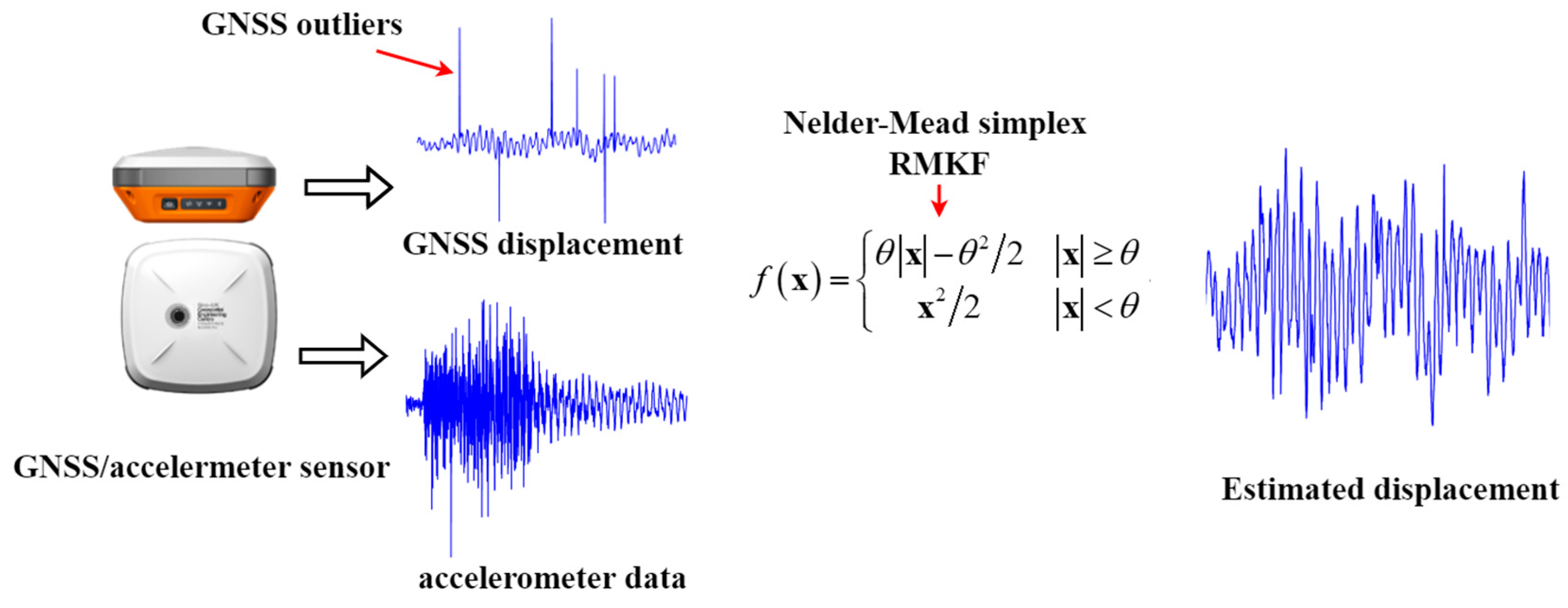

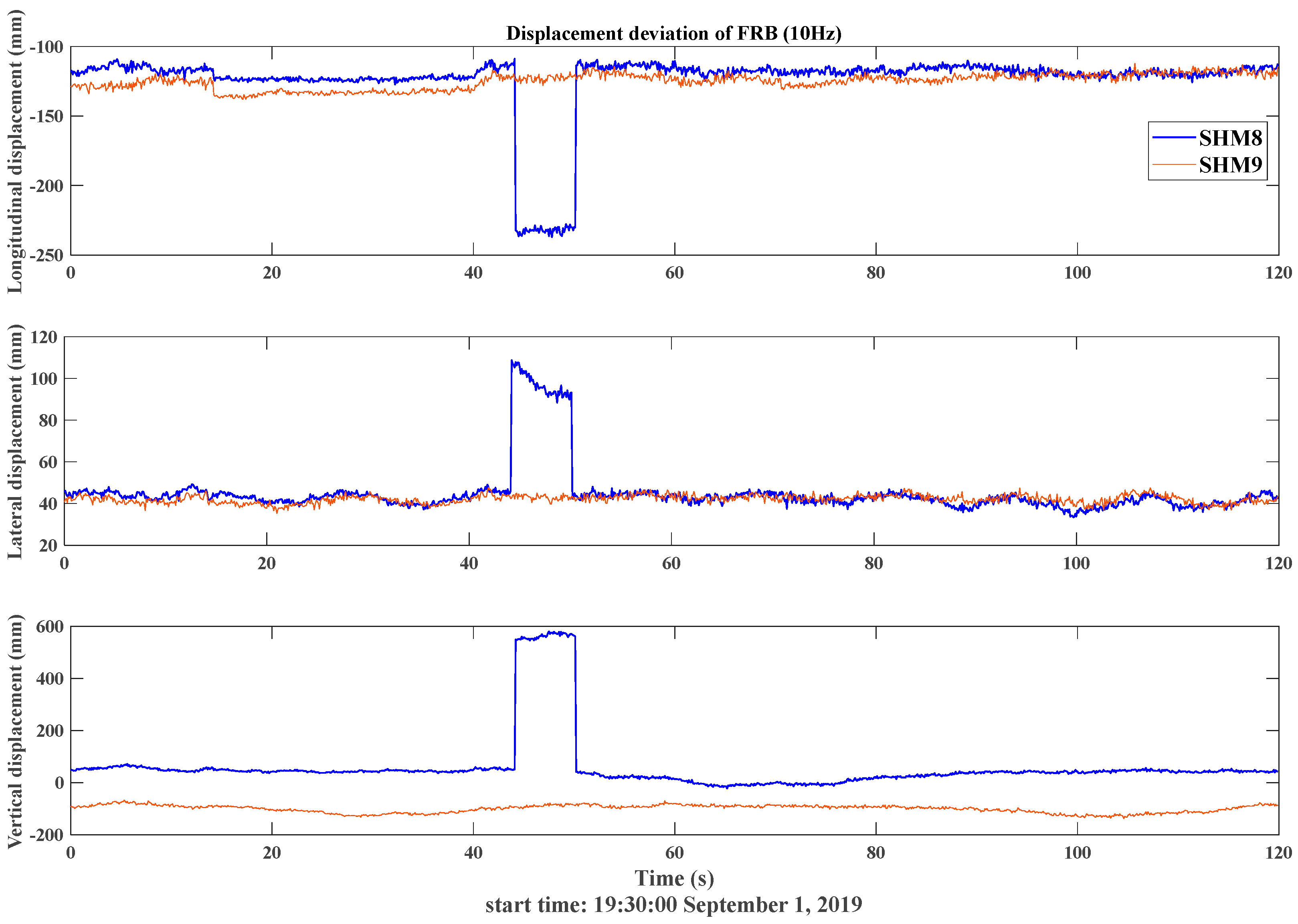
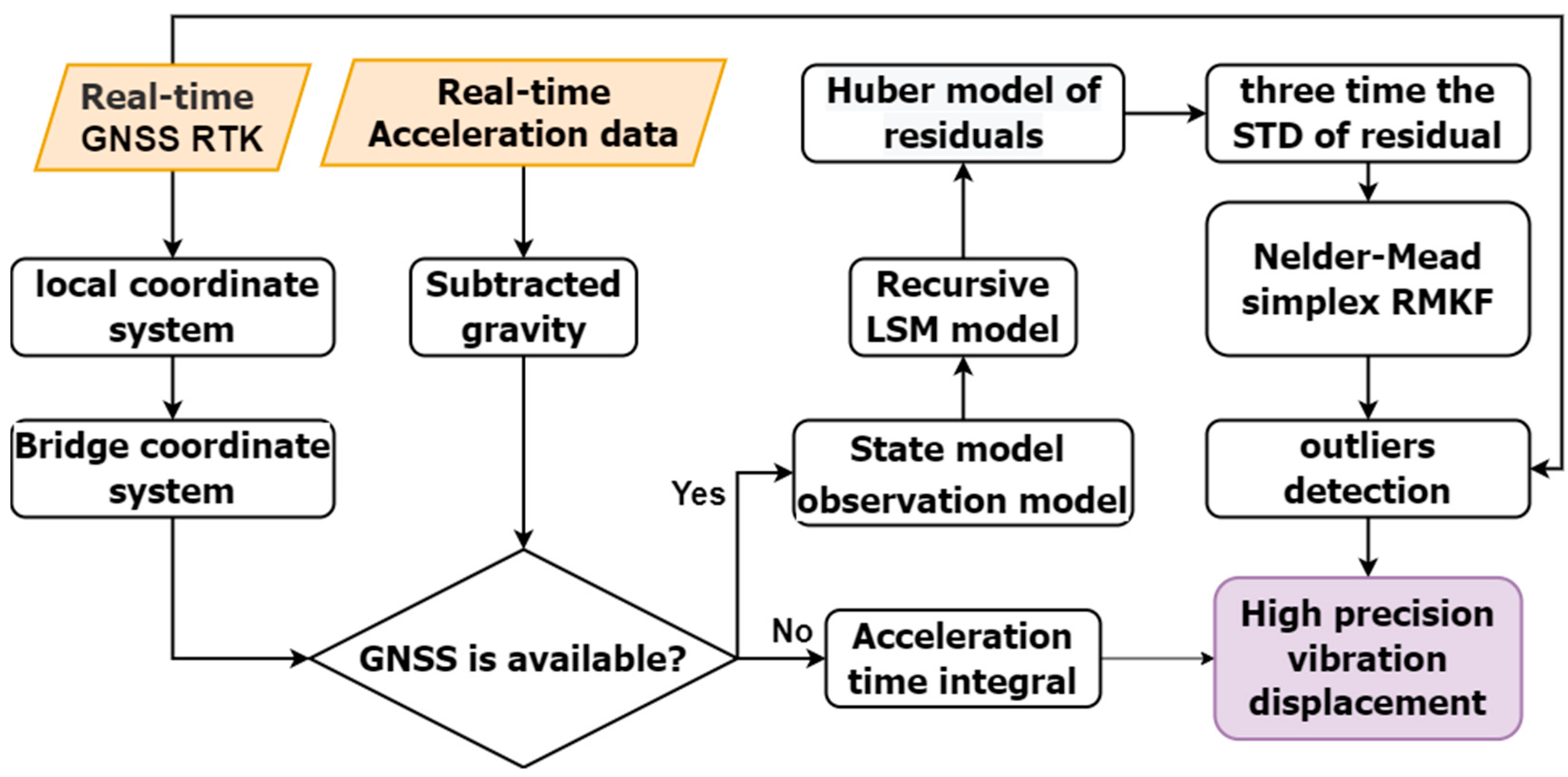
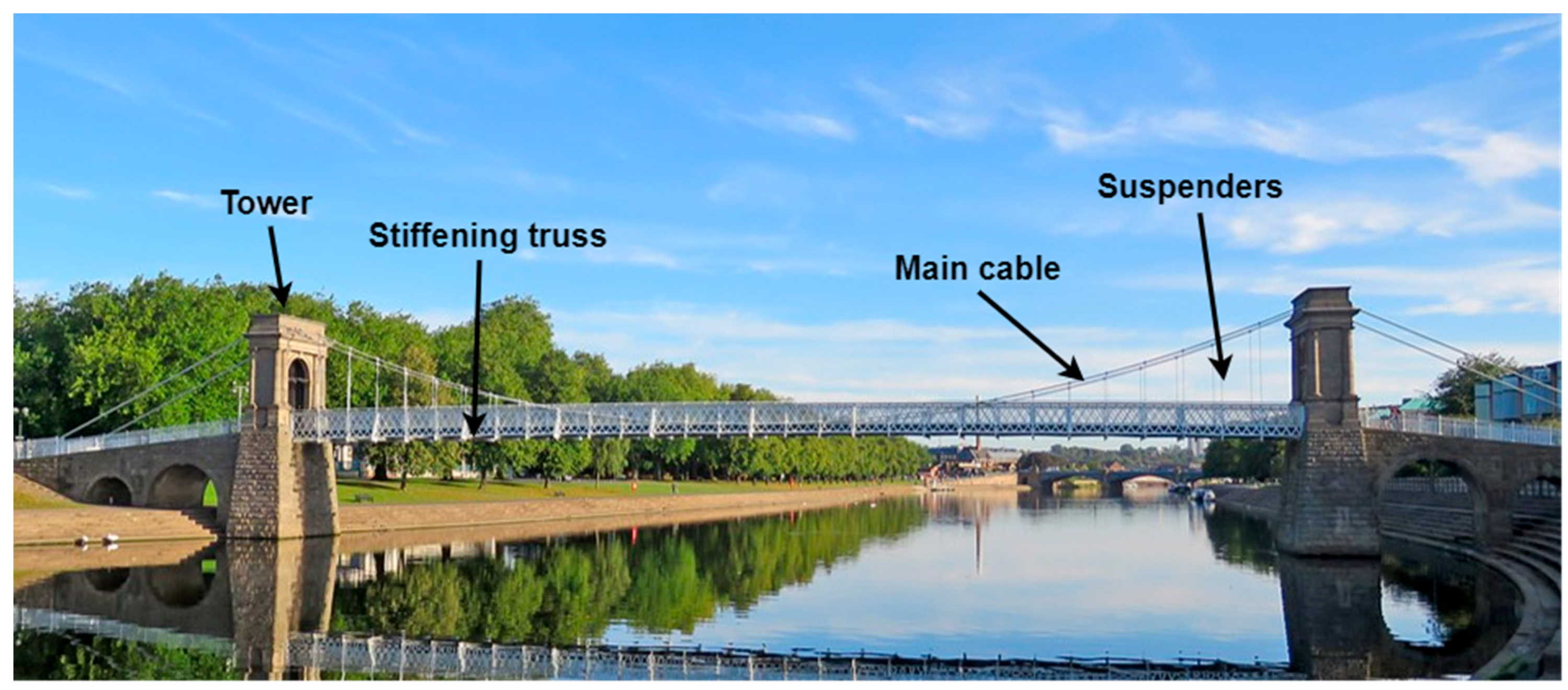

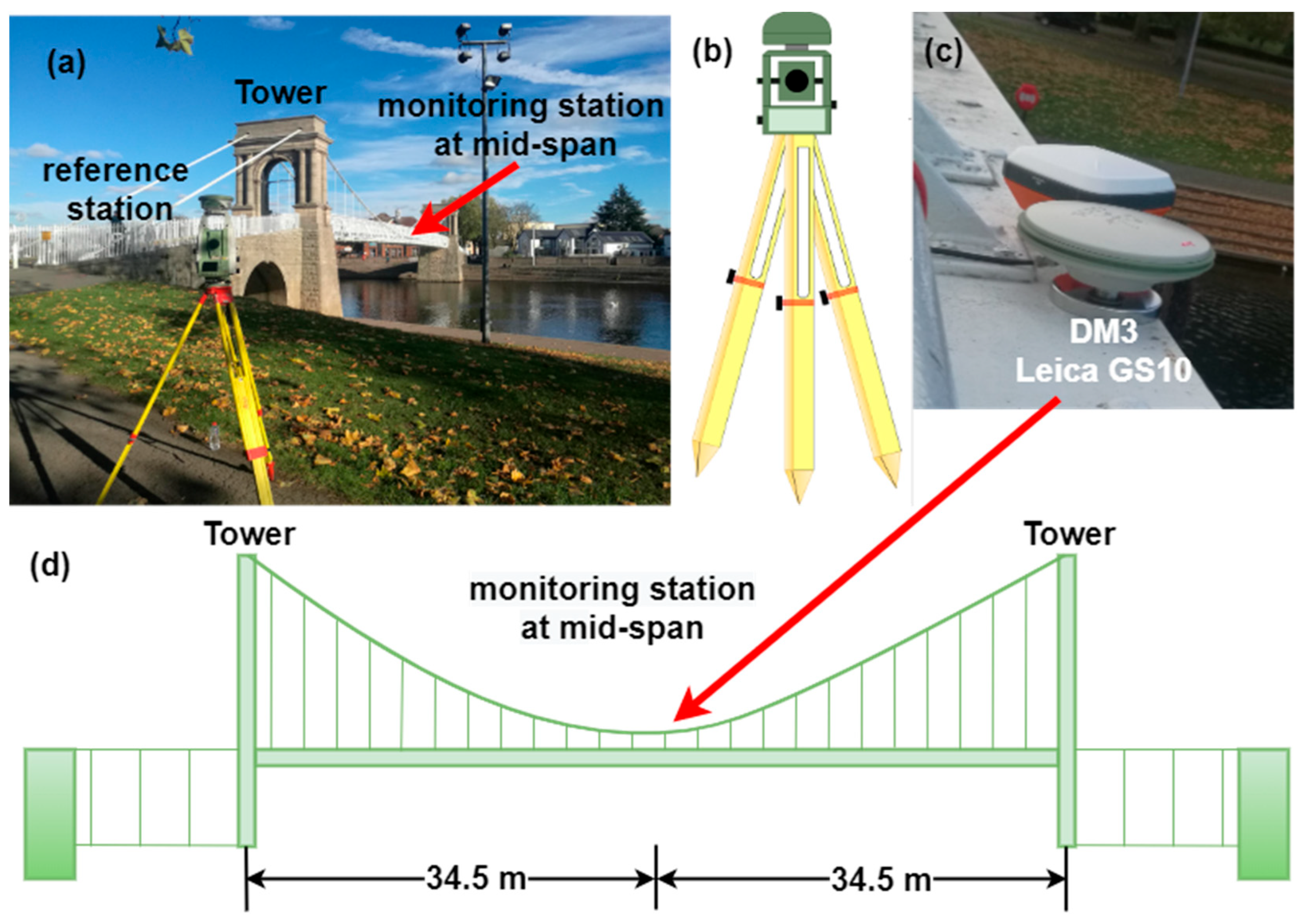
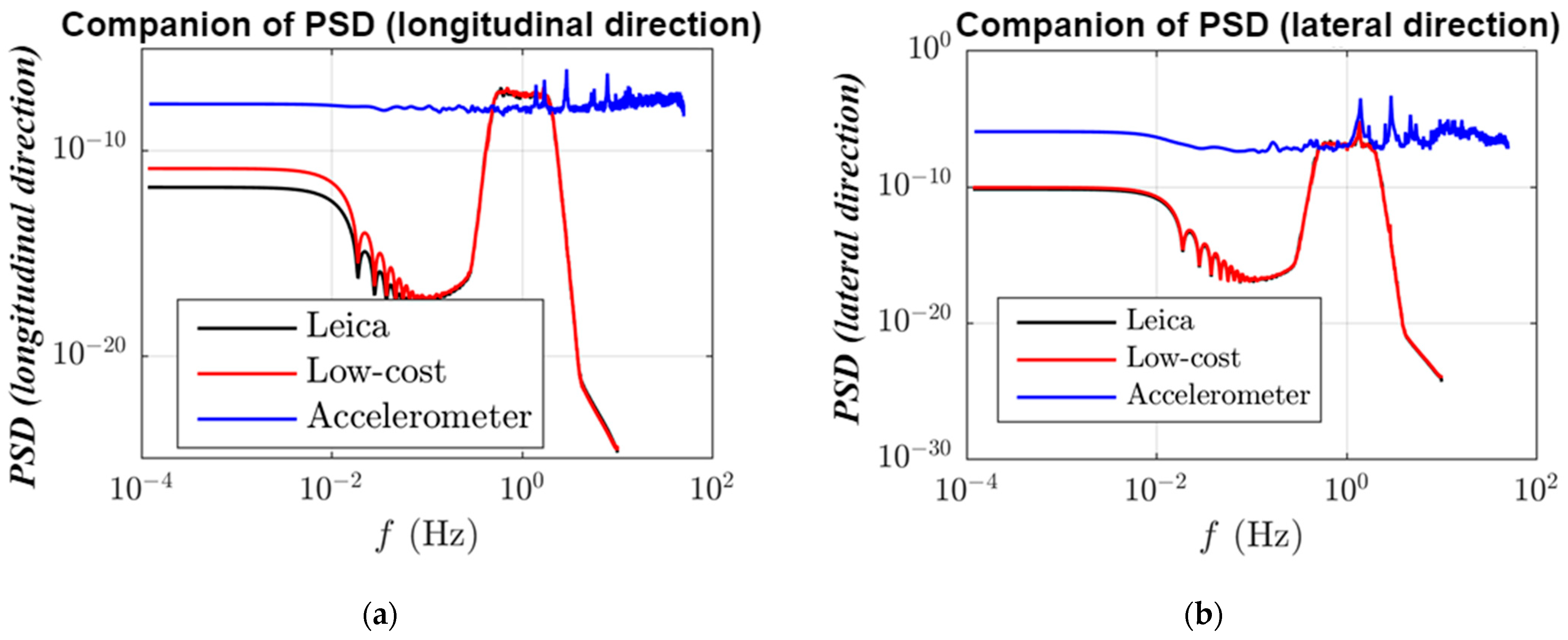
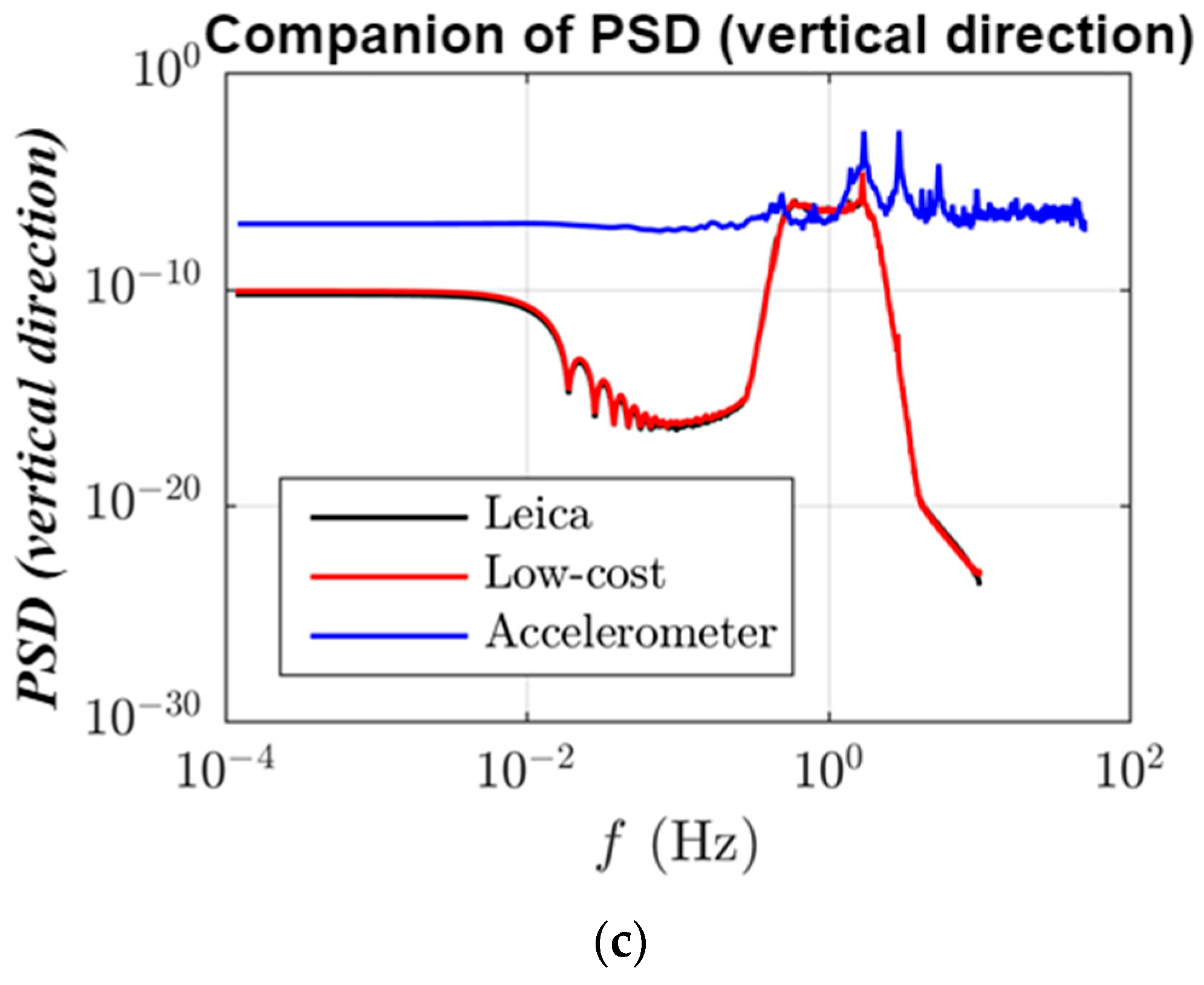
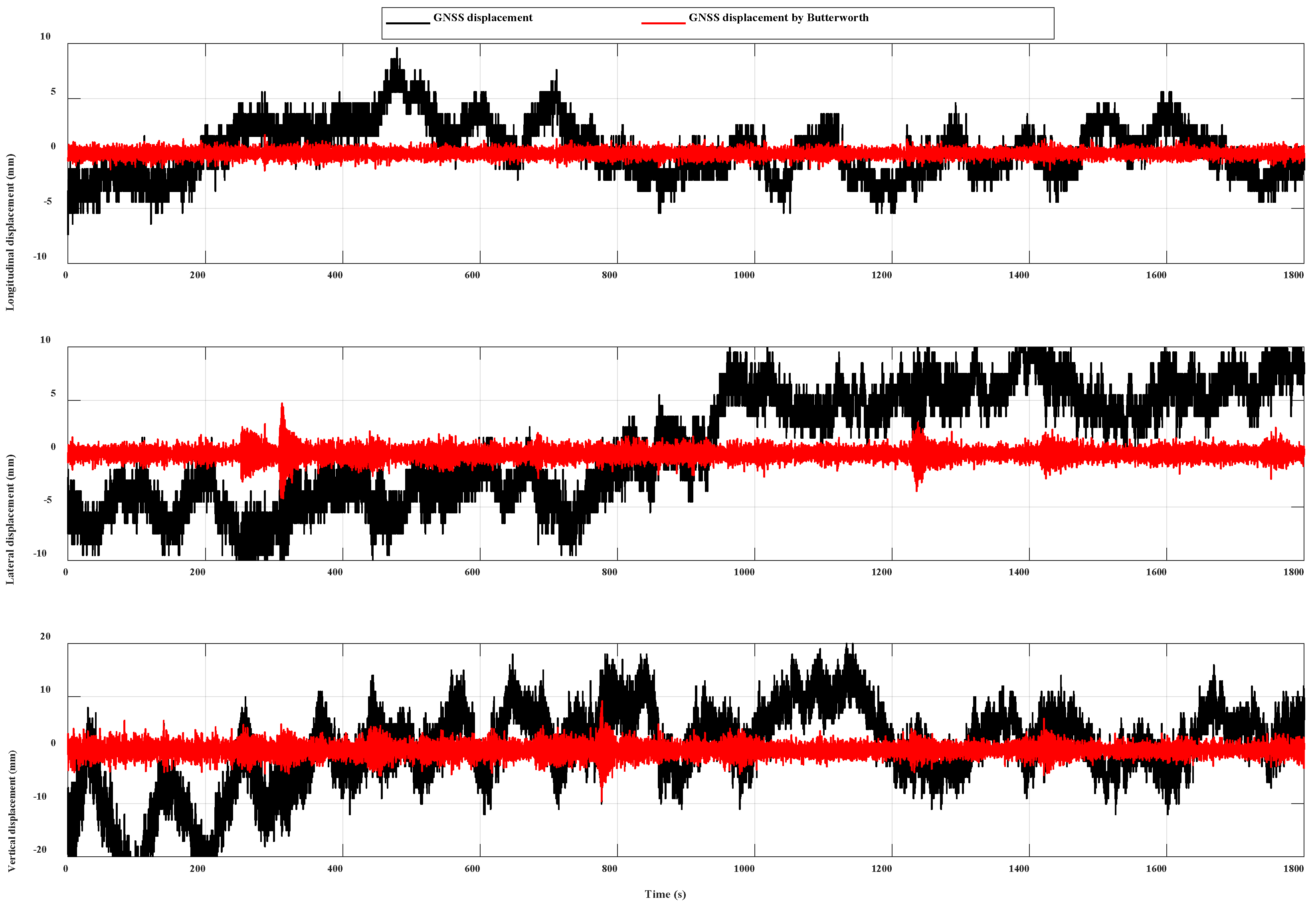
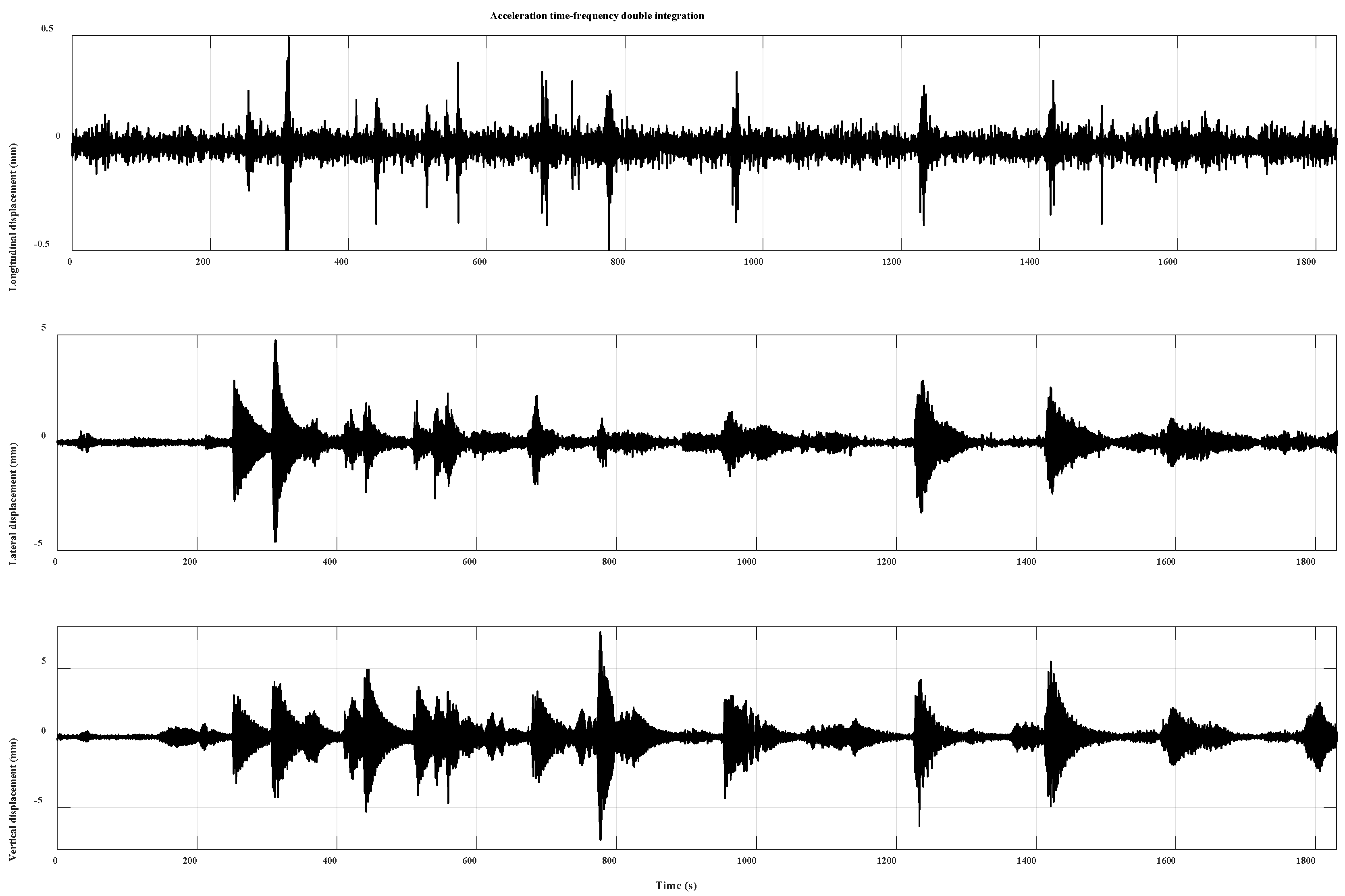

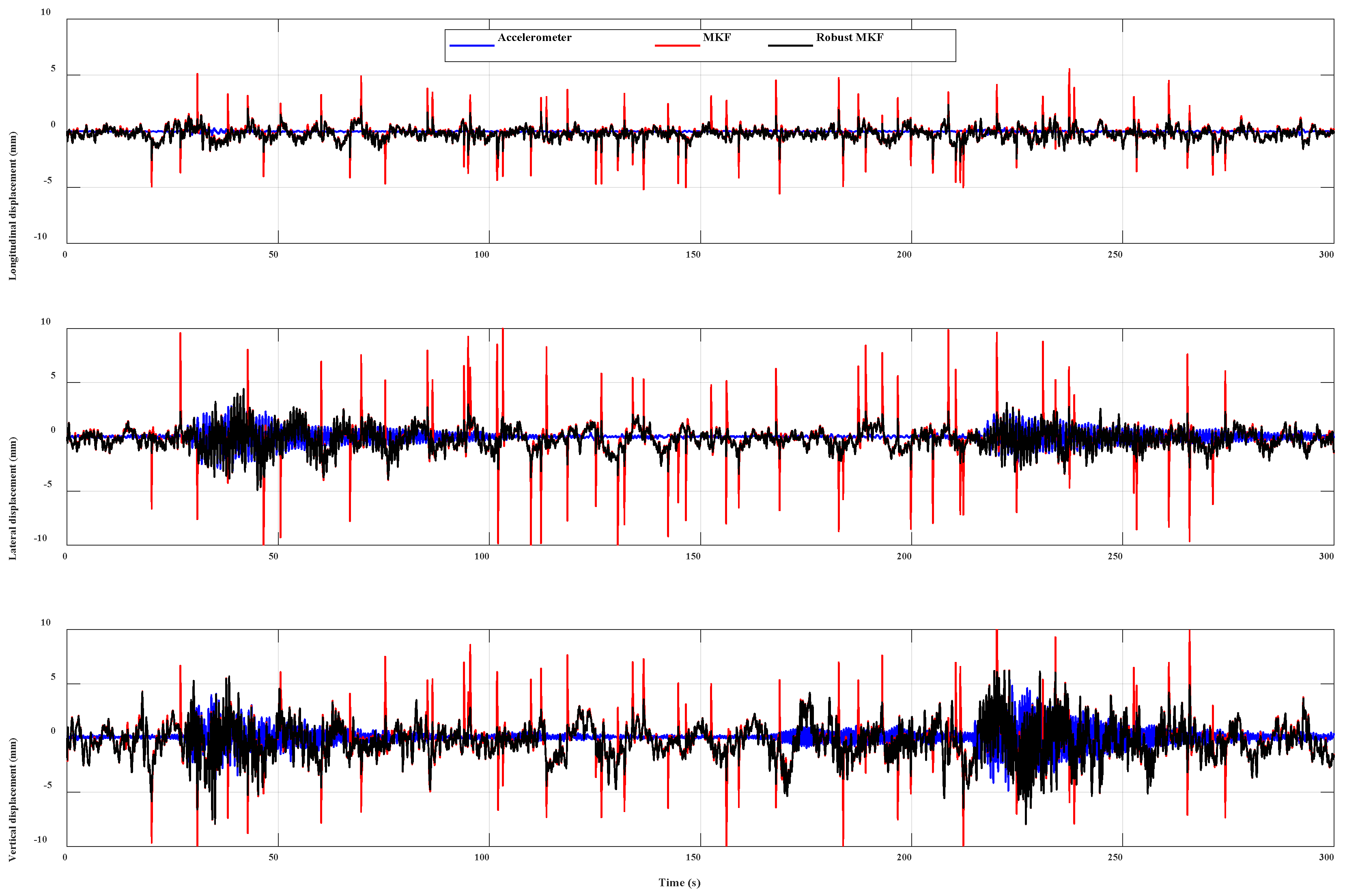

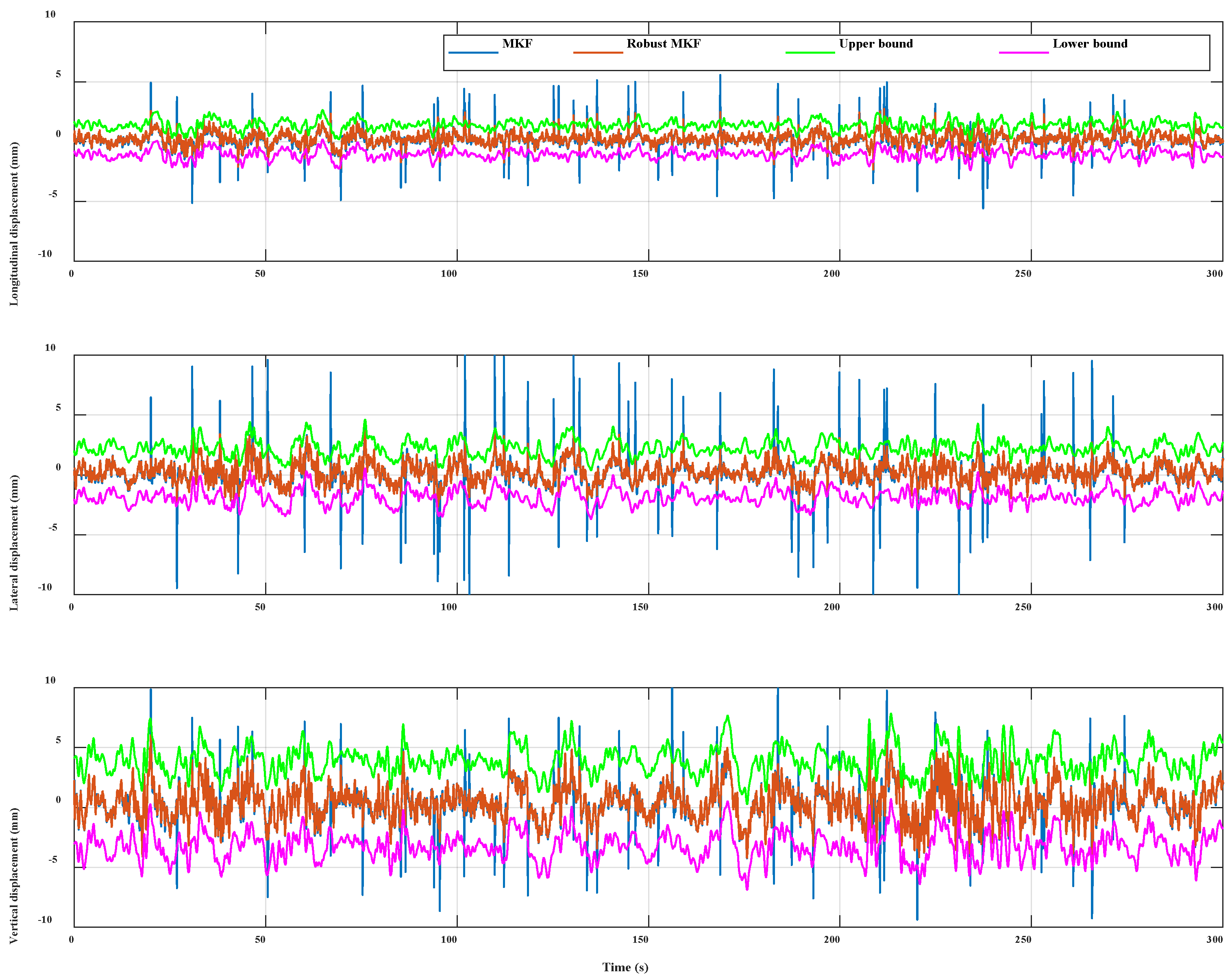
| Mean | RMSE | Max | Min | ||
|---|---|---|---|---|---|
| Longitudinal displacement | MKF (mm) | 0.2 | 0.7 | 5.5 | −5.6 |
| Robust MKF (mm) | 0.1 | 0.5 | 3.3 | −2.3 | |
| improved accuracy (%) | 50% | 29% | 40% | 59% | |
| Lateral displacement | MKF (mm) | 0.2 | 1.2 | 11.0 | −10.0 |
| Robust MKF (mm) | 0.2 | 0.8 | 4.4 | −2.8 | |
| improved accuracy (%) | - | 33% | 60% | 72% | |
| Vertical displacement | MKF (mm) | 0.4 | 1.6 | 10.8 | −9.3 |
| Robust MKF (mm) | 0.4 | 1.4 | 5.8 | −4.2 | |
| improved accuracy (%) | - | 13% | 46% | 55% | |
| Total displacement | MKF (mm) | 0.5 | 2.1 | 16.4 | −14.6 |
| Robust MKF (mm) | 0.5 | 1.6 | 8.0 | −5.5 | |
| improved accuracy (%) | - | 21% | 51% | 62% |
Disclaimer/Publisher’s Note: The statements, opinions and data contained in all publications are solely those of the individual author(s) and contributor(s) and not of MDPI and/or the editor(s). MDPI and/or the editor(s) disclaim responsibility for any injury to people or property resulting from any ideas, methods, instructions or products referred to in the content. |
© 2023 by the authors. Licensee MDPI, Basel, Switzerland. This article is an open access article distributed under the terms and conditions of the Creative Commons Attribution (CC BY) license (https://creativecommons.org/licenses/by/4.0/).
Share and Cite
Hu, L.; Bao, Y.; Sun, Z.; Meng, X.; Tang, C.; Zhang, D. Outlier Detection Based on Nelder-Mead Simplex Robust Kalman Filtering for Trustworthy Bridge Structural Health Monitoring. Remote Sens. 2023, 15, 2385. https://doi.org/10.3390/rs15092385
Hu L, Bao Y, Sun Z, Meng X, Tang C, Zhang D. Outlier Detection Based on Nelder-Mead Simplex Robust Kalman Filtering for Trustworthy Bridge Structural Health Monitoring. Remote Sensing. 2023; 15(9):2385. https://doi.org/10.3390/rs15092385
Chicago/Turabian StyleHu, Liangliang, Yan Bao, Zhe Sun, Xiaolin Meng, Chao Tang, and Dongliang Zhang. 2023. "Outlier Detection Based on Nelder-Mead Simplex Robust Kalman Filtering for Trustworthy Bridge Structural Health Monitoring" Remote Sensing 15, no. 9: 2385. https://doi.org/10.3390/rs15092385
APA StyleHu, L., Bao, Y., Sun, Z., Meng, X., Tang, C., & Zhang, D. (2023). Outlier Detection Based on Nelder-Mead Simplex Robust Kalman Filtering for Trustworthy Bridge Structural Health Monitoring. Remote Sensing, 15(9), 2385. https://doi.org/10.3390/rs15092385









